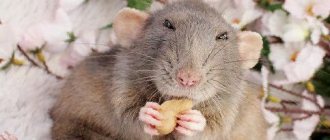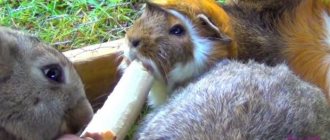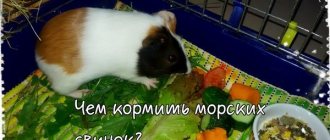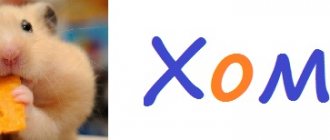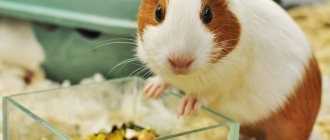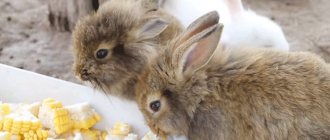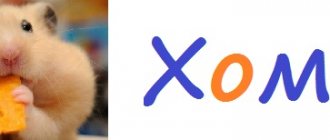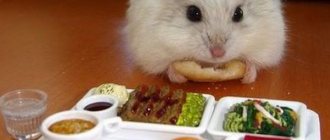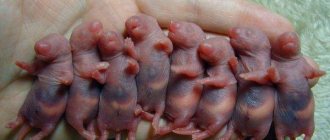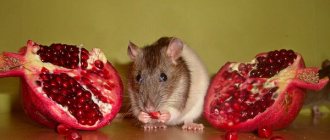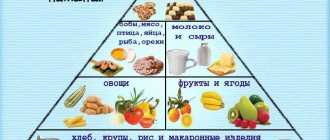Every owner of a decorative rodent is primarily concerned with the question: what do hamsters eat? If you decide to get a furry friend, ask what you can feed him. Small rodents are omnivores and will eat or hide in the pantry everything that catches their eye. Some owners feed their pets what they eat themselves. But this is very harmful for rodents. With such nutrition, the animal will not live long, very soon it will begin to have stomach problems, and everything will end sadly. To prevent this from happening, you need to know what you can feed your hamster, and what it is strictly contraindicated to give it.
What does a rodent eat in nature?
In the wild, the animal’s diet depends on its habitat. These are mainly grain crops, so rodents live, mainly in fields. In drier areas there is more dry food, in wetter areas there is more lush grass, leaves and other greenery. Rodents often raid places where grain, vegetables and other products are stored in rural houses and dachas. Rodents replenish their protein reserves by eating beetles, spiders, worms and caterpillars. They do not disdain the meat of another wounded small animal.
What does a hamster eat at home?
The basic rule to follow when feeding your pet: you can give everything that he can find while living in the wild. The more natural products there are in an animal’s diet, the better for it.
The main types of foods to feed your hamster at home.
- Cereals - wheat, oatmeal, buckwheat, barley, corn. They can be given as whole grains, flakes, or as a porridge cooked in water. Sunflower and pumpkin seeds. Legumes, except red beans.
- Vegetables. Raw carrots, zucchini, pumpkin, bell peppers, eggplants, radishes, radishes. You can also give vegetables boiled without adding salt. It is better to lightly boil beets, broccoli, and cauliflower.
- Greenery, grass, tree leaves. Parsley, dill, lettuce, plantain, young nettle, clover. Young tree branches (apple, pear, birch, maple).
- Fruits and berries. Apples, pears, bananas, cherries, cherries, strawberries. They readily eat rose hips and currants. They love dried fruits (raisins, dried apricots, prunes, pieces of dried apples and pears). Occasionally you can give plums, apricots, and grapes. It is better to remove the seeds.
- Dairy products (low-fat and unsweetened kefir, cottage cheese, natural yogurt).
- Eggs, chicken, fish. Twice a week you can give a boiled egg, a piece of boiled lean chicken or boiled fish. Cook without salt and spices.
- It is better to buy bugs, worms and special insects at a pet store. Hamsters love earthworms, but if you dig them up in a flower bed, you can give your pet an infection.
Pet stores sell dry food for hamsters. It contains essential vitamins and minerals. Try different mixtures to find a food that your pet likes. Such pet food companies as Little One and Vitacraft have proven themselves well.
Food for Dzhungarik
If you ask a veterinarian or pet store employees about what is best to feed your Djungarian hamster, you will almost 100% likely hear about ready-made grain mixtures. Most owners choose them because their composition is carefully thought out by specialists: they contain the required amount of proteins, fats and carbohydrates, and are also enriched with a vitamin complex.
Before purchasing, make sure that you choose food designed for dwarf hamsters. It is unacceptable to offer food for cats, dogs, hares or other rodents.
Then the buyer has to choose:
- grain feed, which consists only of cereals;
- combined, which includes nuts, dried fruits, vegetables and berries.
Typically, ready-made mixtures for Djungarian hamsters contain corn, seeds, oats and crushed nuts. One package lasts approximately two months. If desired, you can supplement the food with approved dry ingredients.
How much do pet hamsters eat?
Your pet is a nocturnal animal, you need to remember this. During the day he sleeps, and at night he eats, plays, exercises on a “simulator,” stores supplies, and sharpens his teeth. Therefore, the best option is to feed the baby twice a day. In the evening - the main meal, a hearty breakfast. In the morning, before bed, have a light dinner.
The amount of food that should be given to an animal at one time depends on the type and size of the rodent. When feeding twice a day, the Syrian is given one tablespoon of the feed mixture, and the Djungarian is given one teaspoon. Campbell's hamsters and other dwarf species feed similarly.
He will hide all the food that the hamster does not eat at one time in the pantry “for a rainy day.” Periodically review these supplies and remove perishable foods so that the animal does not get poisoned. Be sure to put something fresh in place of the “seized valuables”. Otherwise, the baby may become seriously stressed because all his reserves have disappeared, and he will die of hunger in the long, cold winter.
Nutritional features of hamsters
First of all, it is worth noting that hamsters are omnivores, so in addition to plant foods and grains, their diet may also contain meat. Many manufacturers in their range of food for hamsters have mixtures that contain semi-finished meat products, consisting of various small worms, bugs, midges, or produce additional snacks.
Animals in cages, including hamsters, should never be overfed, as this is fraught with serious diseases. Unfortunately, no matter how hard people try, home conditions differ significantly from natural ones, and the pet’s activity is many times lower. Therefore, feed should be poured no more than the amount indicated by the manufacturer. At the same time, many experts recommend removing the bowl or feeder after feeding, rather than leaving it in the cage constantly. The food should be replaced rather than left in the bowl for a long time if the hamster has not finished it, since many ingredients, especially if the food is not of the best quality, can begin to deteriorate from moisture that gets into the bowl.
The type of diet for a pet must be selected depending on the hamster’s age, health status, taking into account the recommendations for a specific type of rodent.
The most popular types of hamsters today are dwarf hamsters, Djungarian and Syrian.
The popularity of these species is due to the friendliness of pets, non-aggression (not counting the breeding period of females), ease of care and nutrition. But there are also some peculiarities. For example, historically and genetically it has developed that for Syrian hamsters it is desirable to have a predominance of grains and a small amount of dried fruits in the food, but for Djungarian hamsters a greater amount of moisture and fruit is needed. And for dwarf hamsters, it is advisable to select food with smaller ingredients that can be conveniently stored in the cheek sinus.
Tips on how to properly introduce new food
You should not suddenly switch from one animal food to another. Many pet owners replace food at one time and at a time, which leads to digestive upset in hamsters. After which the first thing seems to be that the new food is not suitable. It is necessary to introduce a new type of food into the diet gradually over 7-10 days, first mixing the new food with the old one. Every day increasing the proportions in favor of new food.
What should you not give to hamsters?
For hamsters, just like for humans, there are a number of prohibited products that can cause significant harm to the health and even life of the pet.
- Any products containing spices, salt and sugar. These ingredients can lead to serious gastrointestinal diseases or diabetes. Even fruits and dried fruits that hamsters can eat should be given in limited quantities or according to individual needs;
- Flour products (yeast and yeast-free), breakfast cereals, cereals, muesli, etc., unless it is a specially designed product for rodents: the hamster’s body is not adapted to such food;
- Fruits and vegetables that are not in season or not typical for the region where they were bred. Firstly, such products are genetically alien to the hamster’s body. Secondly, it is no secret that out-of-season vegetables and fruits are often treated with special compounds for better storage, which are harmful to health;
- Any food prepared by frying, smoking, or very fatty foods should also not be present in a hamster’s diet;
- Products containing large amounts of starch should be in limited quantities;
- Dairy and fermented milk products.
What can hamsters eat?
Vegetables (starchy and exotic with caution); Fruits (seasonal, not exotic); Dried fruits (well washed, not sticky); Greens (it’s better to buy special ones at a pet store, since hamsters can’t do much); Yolk; Bugs and midges;
How and what do rodents drink?
If there is a large amount of fresh, juicy vegetables, fruits and herbs in the diet, the homa may drink very little or not drink at all. For example, cucumbers are 90% water. However, there should always be fresh water in the cage. The water in the drinking bowl should be changed at least once a day. If debris from the cage gets into the water bowl, the water must be changed immediately so that the animal does not get poisoned. There are several types of special closed drinkers on sale that prevent tipping over and contamination of the water in the container.
Syrian breed
The most common and no less intriguing type. Easy to train. Maintenance is not difficult. It has four toes on the front toes and 5 on the back. The largest of all types of domestic hamsters. Mainly has a golden color. An adult reaches a length of twelve centimeters. The body is plump like everyone else. In everyday life, animals often reach twenty centimeters. Males weigh one hundred twenty grams, and females one hundred and forty. Individuals twenty centimeters in length reach a weight of two hundred grams.
When leaving, the main factor is peace of mind. Under no circumstances should you take your pet out of its cage when there are many people in the room. The noise scares him, he begins to get nervous, and may bite or get sick.
What fruits can pets eat?
Fruits that hamsters eat at home should be fresh and ripe, but without rot. It is better if it is local and seasonal fruits. Citrus and various tropical fruits should not be given. The bones must be pulled out so that the baby does not choke. Sour fruits are contraindicated.
If you are training a baby or teaching him, for example, to use a running wheel, you need to stock up on “goodies.” Sunflower seeds or cookies are suitable for this purpose. Sometimes you can feed your baby a banana. But since rodents constantly need to wear down their teeth, they must eat more solid food. In addition, bananas contain a lot of sugar.
Repeat “fruit” days no more than 1-2 times a week.
Grinding down teeth
To grind down the front incisors, hamsters need to be given branches of young fruit or deciduous trees and shrubs - apple, pear, cherry, plum, birch, linden, maple, raspberry, currant, rose hip. The branches must first be washed and doused with boiling water.
It is forbidden to give hamsters branches of coniferous trees.
You can also suggest a mineral or chalk stone for grinding down teeth.
What do little hamsters eat?
If everything is fine with the mother, the cubs usually do not need additional food. But if for some reason the babies are left without a mother or she refuses to feed them, you will have to feed the babies using a pipette or a painting brush. Buy a special formula for newborns at a pet store and dilute it to the consistency of milk. Newborn babies should be fed every two hours, then gently massage their tummies to improve digestion. Small hamsters need to be provided with a bottle of warm water (not higher than +31 °C).
At the age of two weeks, you can already give baby formula (Gerber, Agusha), thin porridge with water and without sugar, crushed cottage cheese, egg yolks and fresh herbs.
From three weeks you can give pureed “adult” food. As a rule, at this age babies can already eat on their own.
Pregnant and lactating hamsters need more protein foods.
Vitamin supplements
Do-it-yourself food for hamsters cannot always provide your pet with a sufficient amount of vitamins and minerals. In winter, there are no green tops, and vitamins purchased at the pet store in the form of tablets and drops are used as a replacement. They are mixed into the animal's food according to the instructions.
List of prohibited products
What is strictly forbidden to feed a hamster:
- spicy, salty, smoked and canned foods;
- any spices;
- citrus and exotic fruits (lemons, oranges, tangerines, grapefruits, avocados, etc.);
- onion garlic;
- cabbage;
- potato;
- watermelon;
- mushrooms;
- sweets.
The list of prohibited herbs includes cereal leaves and dandelion. The sharp serrations on these leaves can injure your hamster's cheeks. Dandelion should not be given because of the milky juice.
Hamster's daily diet
When choosing what to feed your pet, try to ensure that the food is varied, balanced in composition, and contains vitamins.
| You can give | Not recommended | Forbidden |
| Dry food mixtures for hamsters | Food for other animals or birds | |
| Cereals | Rice (can be given only for diarrhea, well boiled beforehand) | Pasta |
| Vegetables (raw or cooked) | Potatoes, cabbage, onions, garlic | |
| Fruits | Watermelons | Citrus fruits, kiwi, mango, persimmon, pineapple |
| Greens: parsley, dill, lettuce, clover, young nettle | Sorrel, lawn grass, strong-smelling herbs and spices | |
| Sunflower, melon, pumpkin seeds | Watermelon seeds | |
| Nuts | Almonds, acorns, apricot and cherry pits | |
| Wheat sprouts, oats, alfalfa | Bread (black and white), muesli, drops for animals | |
| Legumes | Red beans | |
| Homemade dried fruits | Store-bought dried fruits | |
| Leaves and branches of deciduous and fruit trees | Needles, branches of coniferous trees |
Animal protein is necessary for complete nutrition of a rodent. It is found in the following products:
| Can | It is forbidden |
| Boiled lean chicken meat (breast) | Boiled and smoked sausages, frankfurters, sausages, lard, ham, etc. |
| Yogurt and low-fat cottage cheese (1% fat) | Cheese, sour cream, homemade cow and goat milk, butter |
| Chicken and quail eggs | Honey, ice cream, mushrooms, fruit juices |
| Boiled lean fish | |
| Grasshoppers, butterflies, mealworms purchased at a pet store | Earthworms and other worms from a flower bed or summer cottage |
| Gammarus (dry crustaceans), also sold in stores |
Do not overfeed the animal, do not put more food in the feeder than the prescribed amount. Otherwise, your pet will quickly gain excess weight. Better buy him toys and a running wheel so that he moves more and does not suffer from obesity.
If you liked the article, leave a review. Write to us what else you would like to know about your little pets.
General rules
“One adult hamster can be given no more than 2 tbsp per day. l. stern". Who came up with this phrase? A rodent should always have food. Maybe he will only eat a teaspoon. But, if there is little food in the feeder, he will begin to make reserves instead of normal nutrition. Moreover, it is completely indiscernible whether they are seeds or raw carrots. Then all this stuff begins to rot, mold and stink. Do you need it?
Don't be greedy, give your hamster more food. He will understand that there is no need to worry about the future, and he will eat no more than he should.
“Sometimes you can pamper your hamster with sausage or sausages.” What nonsense. The current sausage contains so many “useful” substances that Mendeleev and his table would cry with envy. And then feed the poor animal!
No sausages, smoked meats or fish! Just one bite can kill your rodent.
“Cook porridge for your hamster in milk, adding a little sugar and salt for taste.” More like a recommendation on how to kill an animal. Because:
- Hamsters should not be given milk! By the way, cheese is also undesirable. You can have a small piece of unleavened cottage cheese once a week, or it is better to replace it with boiled chicken protein.
- Sugar and salt are strictly prohibited! It's deadly. And a tiny dose is enough.
- Cereals are given to hamsters only in raw form. Boiled ones can cause constipation and severe gas formation.
One gets the impression that such would-be advisers generally write from idiots and have never even seen a hamster in a picture.
“To grind down teeth, place pine or spruce branches in the cage.” In principle, hamsters need wood. But not coniferous. Let these be branches of any deciduous tree. Be sure to wash them and, if possible, remove the bark.
“Hamsters are steppe animals and can go without water for a long time.” Another heresy. Only camels can survive without water for a long time. And hamsters need it. Therefore, there should always be liquid in the drinker.
By the way, you don’t have to watch how much the rodent drinks. It may seem to you that the fluid is not decreasing. But that’s why he’s a hamster, not a camel, so he can drink just a little. Rest assured, he does this regularly.
“If there is no special food on sale, then purchase it for any other rodents.” No, this is just some kind of mockery! I would also advise you to buy cat or dog food. Just to be sure.
Rest assured, a hamster will eat anything, but then do not be surprised by the sudden death or illness of the animal. It’s better not to buy anything at all than to conduct such experiments.
“Occasionally, give your rodent a piece of pineapple or avocado.” What nonsense! Where do such exotic fruits come from in the steppe? In general, if you doubt whether you can give your pet a product, then just use logic. This happens in the natural environment, so feel free to offer it to your hamster. This doesn’t grow in the steppe zone, so give up the idea.
For example, bread, cookies, crackers. There is no doubt that most rodents love these products. But bread doesn't grow on trees. Accordingly, it is not recommended to give such a treat to a hamster, even sometimes.
Or almonds. Well, it looks like a nut, are they ok for rodents? But no. Almonds are not a nut, but a kernel from a seed. Everyone knows that hydrocyanic acid is poison. And that it is contained in the kernels of almost all stone fruits: apricots, almonds, plums, cherries. This treat will quickly make your hamster stretch out its legs. And yes, these trees do not grow in the steppe.
